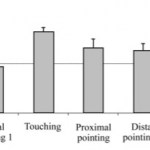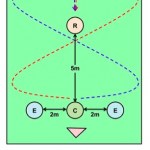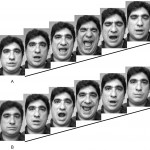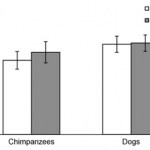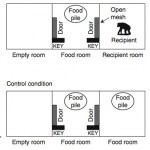social cognition
Quandaries such as those involving stealing a drug to save a spouse's life or whether or not to have an abortion have historically dominated the study of the development of moral thinking. The predominant research programs in psychology today use dilemmas in which one choice is deontologically correct (it is wrong to rotate a lever that will divert a train and kill one person instead of five), and the other is consequentially correct (kill one person if it will save five others).
It is not surprising that psychologists have followed philosophers in proposing definitions for morality that…
Dogs are pretty smart. They can have huge vocabularies, they can infer meaning in the growls of other dogs, and they can effortlessly figure out if other dogs want to play or fight with them. But their intelligence might be limited to the social domain; indeed, while they outperform chimpanzees in social tasks, chimpanzees outperform them in many other tasks. And they might have developed their impressive social skills as merely an accident of natural and artificial selection.
Previous research has shown that dogs can use lots of different forms of human communicative signals to find food,…
Figure 1: A mother hyena with her cubs.
Early developmental experiences can have significant implications for the growth, behavior, survival, and reproductive success of an individual. In many species, one of the most important factors that affects an individual's early development is the maternal environment. However, mothers not only provide an environment for their offspring, but also half of their genes, making it difficult to separate the effects of nature and nurture when investigating developmental outcomes in the offspring. Moreover, because male mammals usually disperse from the…
A fascinating new paper just came out in Nature Communications and I intend to blog it in the usual manner, but I thought I'd try something new first. Check it out:
The Research Question
...According to life history theory, mothers should invest in their offspring if this enhances offspring survival and fitness, and if the fitness benefit to mothers from increased offspring fitness exceeds the cost of their investment. Whether the maternal environment influences the fitness and reproductive value of sons is unknown in most mammals because male mammals usually disperse and, thus, few studies…
I will be reposting some dog-related posts from the archives in the coming few weeks as I prepare for the course I'm teaching this semester on dog cognition. Please let me know if you find something inaccurate or unclear.
Domesticated dogs seem to have an uncanny ability to understand human communicative gestures (see here). If you point to something the dog zeroes in on the object or location you're pointing to (whether it's a toy, or food, or to get his in-need-of-a-bath butt off your damn bed and back onto his damn bed). Put another way, if your attention is on something, or if your…
In most zoos and animal parks, polar bears (ursus maritimus) attract such a disproportionate amount of attention that they are referred to in the industry as "charismatic megafauna," or in other words, "really cool animals." Perhaps it is because it is especially rare for the average zoo-goer to happen upon a polar bear in the wild, or because they live in such an inhospitable environment. Perhaps it's just because polar bears are so damn cute.
Maybe we should just blame Coca-Cola.
Whatever the reason, psychologists Michael J. Renner and and Aislinn L. Kelly of West Chester University in…
Different dog growls mean different things, right? Probably. But can you tell the difference?
Here's a dog growling when someone is trying to steal its food: link to mp3.
Here's a dog growling at a stranger: link to mp3.
You probably can't tell the difference. Neither could I. Dogs can. Surprised? Probably not. But, this is the first experimental evidence that dogs use different communicative vocalizations during social encounters with other dogs and with humans, depending on the situation.
The researchers recorded dog growls in three contexts: food guarding from another unfamiliar dog (…
In general, the ability to attribute attention to others seems important: it allows an animal to notice the presence of other individuals (whether conspecifics, prey, or predators) as well as important locations or events by following the body orientation or eyegaze of others. We've spent a lot of time here at The Thoughtful Animal thinking about how domestication has allowed dogs to occupy a unique niche in the social lives of humans. They readily understand human communication cues such as eye-gaze and finger-pointing, and capitalize on the infant-caregiver attachment system to have their…
From the archives...
Figure 1: Does Mickey feel empathy?
It probably depends on how you define empathy. Empathy, by any definition, implies emotional sensitivity to the affective state of another. Sometimes the empathy response is automatic or reflexive, like when babies start to cry upon hearing another baby crying. Sometimes a strong cognitive component is required, such as for compassion. A more specific understanding of empathy requires similarity between the affective states of the observer and the observed, with an understanding that the observer feels a certain way because he has…
It's been a pretty long stressful week around here, and not just because of Pepsipocalypse and the resulting fallout. But, well, I'm back, and I have an awesome paper to tell you about. When I saw it I just KNEW it had to be blogged.
Mythbuster Adam Savage sets the yawning in motion in Mythbusters attempts to start a yawning epidemic across the globe
Did watching that video make you yawn? Chances are it did, and you can thank contagious yawning for it. What is contagious yawning? Contagious yawning is a very well-dcoumented phonemenon wherein yawning is triggered by the perception of others…
She: "What are you writing about?"
Me: "Cognition in cold-blooded animals."
She: "Hot."
Most people who study cognition focus on mammals or birds. But I hope I've convinced you that other animals are important to investigate as well. One research group at the University of Vienna likes cold-blooded critters. Turtles and lizards and such. They argue:
Reptiles, birds and mammals have all evolved from a common amniotic ancestor, and as such they are likely to share both behavioural and morphological traits. However, this common ancestor lived around 280 million years ago and so it is equally…
I've been watching with interest a recent kerfuffle involving a relatively new blog in the sciblogosphere, Academic Jungle, which is written by the pseudonymous blogger GeekMommyProf.
Prof-Like Substance has already written a good summary of recent events, so I won't duplicate his efforts. Instead, I'll duplicate his text! (Bracketed bold text inserted by me):
GeekMommyProf started a blog about a month ago, which burst onto the scene in a hurry. Most blogs (including this one) toil in obscurity for a while, eventually gain some steam and get enough readers coming back to get talked about a…
Dogs are particularly good at tasks that involve communicating or cooperating with humans, which has led some researchers to speculate that they are really good at solving social tasks, more generally. For example, dogs can figure out where a human's attention is, are really good at picking up on eye-gaze and finger pointing cues, distinguish among different individual humans (by contrast, humans are really bad at distinguishing among different individual monkeys, for example), and at least in one outstanding case, are capable of "fast mapping."
Relative to non-human primates, domestic dogs…
Bonobo Week continues! I'm donating whatever proceeds I receive from my blogging shenanigans for the entire month of June to help the bonobos at Lola Ya Bonobo.
Primate researchers used to think that only humans voluntarily share their own food with others. At the time, it was a reasonable conclusion to make, since lots of studies indicated that chimps don't. But that was before anyone checked to see if bonobos were willing to share their food with others.
So Brian Hare and Suzy Kwetuenda tested pairs of the bonobos from the Lola Ya Bonobo sanctuary in DRC. In all cases, the two…
Yesterday afternoon, I watched the livestream of the "All Creatures Great and Smart" session of the World Science Festival in New York City. The session was absolutely fantastic, and featured Brian Hare, Vanessa Woods, Jeremy Niven, Patrick Hof and Klaus Zuberbühler.
The conversation challenged long-held assumptions about the differences between "animal" and "human", and included fascinating discussion about pin-sized brains that can count, categorize, and hold a grudge against those who've tried to swat them. Does your dog really think and feel like a human? Do our closest primate…
[It's a really busy week over here at blog headquarters, because it is data collection week. Data collection week is awesome, but it means less time for blogging. So here's a piece from the archives. I picked this one especially for Drugmonkey, because he liked it so much.]
The Harpy Eagle (Harpia harpyja) is a nasty scary-looking muppethugging monster of a carnivorous bird. Female harpies weigh 14-20 pounds, and males weigh 8.5-12 pounds. They stand between 2.9 and 3.5 feet tall. The wingspan of the harpy eagle can reach 6 feet, 7 inches. The talons - sharp claws to grasp onto its prey -…
Let me tell you a little story. When I was born my parents had two cats. One was named Garfield. The other...well, I don't remember what the other one was called. Not long after I was born, and little Jason was coughing up furballs, the doctors informed the parents that their little bundle of skin and hair was allergic to cats. It was then that teams were picked and lines were drawn. It was me or the cats. Luckily, the parents decided to keep me, and lose the cats. Imagine how much it would have sucked if they decided to keep the cats and lose me. I imagine if my younger brother had actually…
What information is contained in the call of a mammal? Some calls might reflect the internal emotional state of the animal, like fear or anxiety, or they can refer to an external object, agent, or event, like the presence of a predator. Rhesus monkeys, lemurs, baboons, and guinea pigs, for example, will produce calls when separated from their conspecifics or in the presence of a stranger. Howler monkeys produce specific alarm calls for avian predators, even when they have never encountered an avian predator for several generations. Vervet monkeys produce different calls in response to…
The party isn't over yet! Here's another helping of Monday Pets. Enjoy!
Wild Dog crawled into the Cave and laid his head on the Woman's lap... And the Woman said, "His name is not Wild Dog any more, but the First Friend."
--Just So Stories, Rudyard Kipling.
Archaeological evidence indicates that dogs were already a part of human society around the end of the Ice Age. Small dog skeletons have been unearthed in human communities as far back as 6- to 12-thousand years ago in Europe, the Middle East, and China. The jawbone of a domestic dog was found in a late Paleolithic grave in Germany, and…
The party continues! Today you get a double-dose of Monday Pets. Here's one from the archives. Later today, you can expect a new one.
I often write about animals that the average person does not interact with all that much on a day-to-day basis. Today, I introduce something I like to call "Monday Pets". The focus of Monday Pets will be the animals that we intentionally bring into our lives as pets. Sometimes those animals are even considered part of the family. Ever notice some weird behavior that you notice your pets doing? Want to know more about it? Email me. Always wanted to know if your…

